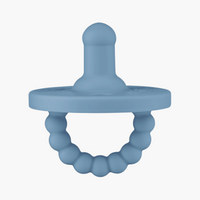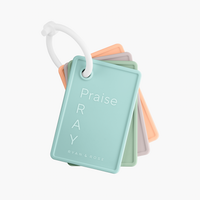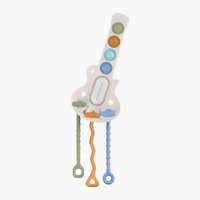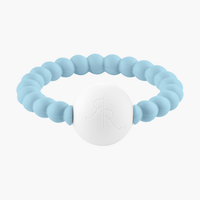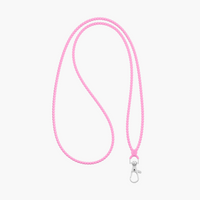Let’s talk pacifiers and sleep. As a mom or dad of a new baby, it becomes evident quickly that your baby will need you 24/7.
Although this is the natural flow and rhythm of being a parent, encouraging your child to self-soothe can be quite helpful. As first time parents, the pacifier was one way that we were able to find a bit of independence for our child as well as some sanity for ourselves...even if that meant getting up a few more times during the night to replace it.

Our friend Cara Dumaplin (@takingcarababies), the founder of Taking Cara Babies, is a sleep expert and her courses are extremely insightful. She has created a helpful tip for babies five months and older to replace the pacifier all on their own, which develops a more independent sleeper.
“The Binky Game” is an activity to practice with your child during your time together—siblings can even participate too! The goal is to work on independent pacifier replacement with your baby.
The Binky Game - Teaching Your Child to Self-Soothe
To play “The Binky Game,” follow these steps:
- Simply place multiple pacifiers around your child, either during tummy time or while they are sitting up.
- Encourage the child to grab for them and place the pacifier in his or her own mouth.
- Be sure to give lots of praise when the task is completed! Reinforcement of this skill will make it easier for your little one to find their pacifier in the dark.
- Place multiple pacifiers in your child’s crib (4-6) so they have easy access to one during the night. The game will teach them to reach and replace their pacifier, and self-soothe.
- Play the binky game on a daily basis until your child is able to self-soothe easily.
Watch Our Video (in collaboration with @takingcarababies):
Things To Remember — What We Had To Remind Ourselves Of:
(just like Cara mentioned in her post, this is in regards to when your child is 5-6 months and older)
Give your child time to learn:
When you’re practicing self-soothing and soothing with a pacifier, give your child some time to learn. I remember we were a bit too eager at times to hop up and replace our baby girl’s pacifier. Once we gave her a few minutes to calm down and find her pacifier, she was able to put it in her mouth and go back to sleep. Of course, there were times she couldn’t find her pacifier and we had to go in and help her.
Over time she learned to search for her pacifier, put it back in her mouth and go back to sleep without much disruption at all.
It's all about consistency:
Each phase and milestone requires consistency to build rhythms. It was hard at first, but if our baby girl lost her pacifier during nap time or during the night, we would give her 5 minutes to find it, put it back in, and then go back to sleep. Of course, some nights we'd be quicker to hop up and find it for her (it's hard to wait especially if she's crying). But it's the consistency of letting her search around, find it, and then soothe back to sleep that led to much better sleep for all of us.
Consistency also comes down to having the same nap and bedtime routines. We established these routines each time—like having the same blanket, same bedtime (if at all possible), same sounds (using a sound machine), singing the same songs, etc. All of this helped build consistent rhythms that taught her it was time to rest. Of course, never perfect but it has certainly helped so much to have consistency.
Keep pacifiers nearby (plenty of them):
Like Cara mentions, keep pacifiers around and within reach for your child. Put a few pacifiers in your child's crib so they can easily locate them if they lose their first one while sleeping. This allows them to calm down and soothe back to sleep in the middle of the night without always waking you to replace their pacifier.
Talk about your routines and rhythms:
Don't be afraid to share your routines and rhythms with other caretakers—such as family members or babysitters. Consistency matters for all who are involved in taking care of your little one.
I remember we expressed our routines to our family member whenever they'd watch our little girl. This helped set expectations for how we do things and how we want others to be consistent in taking care of her and building those rhythms.
Set those expectations and communicate them clearly. A caretaker won't know until you let them in on your rhythms and routines. And then allow them to help you develop those in your child.
Do what works for you:
At the end of the day, it's your child and you're the parent. Do what fits you and your family. We all do things slightly different than the next person. Take advice from pros who have studied and researched, like Cara, but remember to build rhythms that fit you and your child. Do what's best for your family.
Discover More...
If you're interested in learning more about our Cutie products—from Cutie PATs to Cutie Clips and more—we encourage you to follow us on Instagram @ryanandrose and join the Cutie Community where other incredible members have built a meaningful community to help one another.
Named of its function, the Cutie PAT is both a Pacifier and Teether in one. It's made of 100% medical-grade silicone and comes in three styles: round stage 1 (for babies without teeth), round stage 2 (for babies with teeth), and flat (for babies that prefer a flattened nipple).
You can shop all of our Cutie PATs here on our website, including limited edition colors, or you can find our core colors at your local Target store and on their website!




